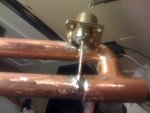conve36
Member
As in the picture below, my question is; (measurments not exact, just example)
If I am to attach the PL-259 chassis mount at say 1.5inches from the grounding point, where do i stop measuring? The middle of the chassis mount or the closest end of the chassis mount to the grounding point?
This is a hard question to "word" so I hope someone understands what I mean...
If I am to attach the PL-259 chassis mount at say 1.5inches from the grounding point, where do i stop measuring? The middle of the chassis mount or the closest end of the chassis mount to the grounding point?
This is a hard question to "word" so I hope someone understands what I mean...


